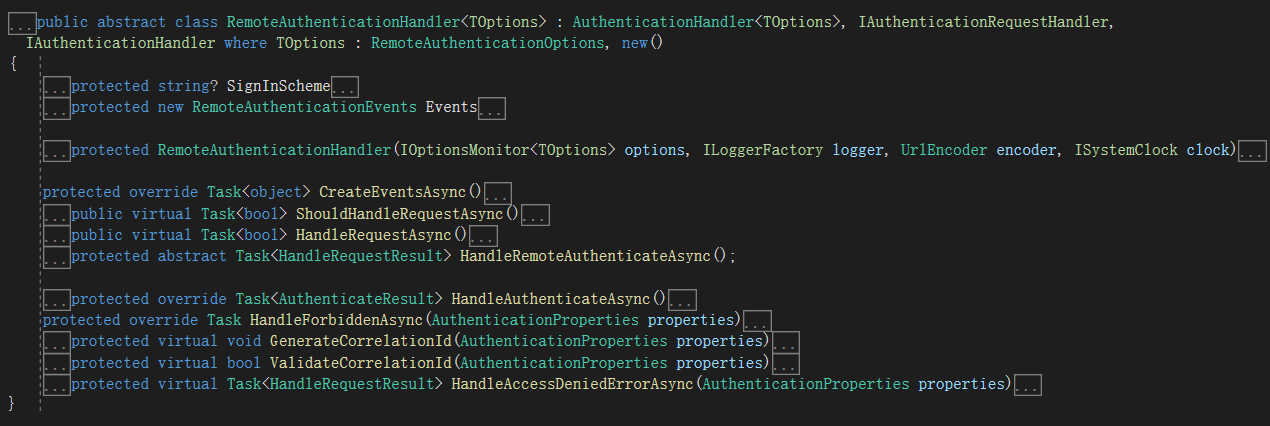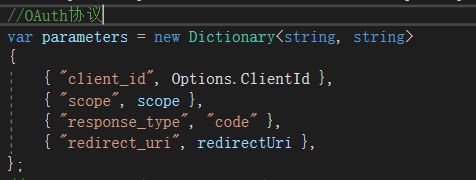.net core 第三方登录---关于AddOAuth
在.net 如果需要用到认证授权,第三方登录,肯定离不开 AddAuthentication(),他的实现就是AuthenticationHandler,如果是需要添加自定义认证就可以去重写AuthenticationHandler,尽管有些认证我们没有看到服务注入AddAuthentication,但是实际上他们源码都是去重写了他,我们平时用到的都是他们封装好了的,例如Identity,AddMicrosoftAccount等等

我们这里介绍的第三方认证其实也就是在AuthenticationHandler的基础上实现的。
先看看AuthenticationHandler的子类RemoteAuthenticationHandler,看这个名字就知道是远程认证,所以当我们需要远程认证的时候就可以去重写RemoteAuthenticationHandler,微软已经给我们提供了,不需要我们去重写AuthenticationHandler。

再看看RemoteAuthenticationHandler的子类OAuthHandler,这个类名包含了OAuth,所以它就是基于OAuth协议来实现的地方认证,如果要使用他必须要满足需要认证的第三方认证服务必须是基于OAuth协议的。
再进入今天的主题 AddOAuth ,他的主要实现就是去实现了OAuthHandler,我们平时如果需要用到的第三方认证是基于OAuth协议的话,那我们就可以用到它了,例如当我们用微软账号第三方登录,QQ登录,微信扫码登录,IdentityServer4等等都是可以通过AddOAuth 实现的。这里可以看到.AddOAuth的几种方式

大概就是两种方式,一种需要注入OAuthOptions和OAuthHandlerSource去实现,这里可以去继承重写这两项;另外一种就是不去重写这两项,默认用原生的OAuthHandlerSource去实现。
例如IdentityServer4的认证,下面这个是通过第一种方式去实现的登录的,我这里用OAuthHandlerSource去重写了OAuthHandler
builder.Services.AddAuthentication()
.AddOAuth<OAuthOptions, OAuthHandlerSource>("SourceIdentity", options =>
{
options.ClientId = "fcbtest";
options.ClientSecret = "fcbtest";
options.Scope.Add("openid");
options.Scope.Add("profile");
options.SignInScheme = "Cookies";
options.SaveTokens = true;
options.CallbackPath = new PathString("/Test/OauthRedirct2");
options.AuthorizationEndpoint = "http://192.168.0.66:7200/connect/authorize";
options.TokenEndpoint = "http://192.168.0.66:7200/connect/token";
options.UserInformationEndpoint = "http://192.168.0.66:7200/connect/userinfo";
})
还有另外一种方式,不去重写这两项,默认用原生的OAuthHandlerSource去实现,直接去重写相应的事件就可以了,具体的注释已经写在上面了
.AddOAuth("localhost", options =>
{
options.ClientId = "fcbtest"; //ClientId
options.ClientSecret = "fcbtest"; //ClientSecret
options.CallbackPath = new PathString("/Test/OauthRedirct"); //获取Code之后的回调地址
options.AuthorizationEndpoint = "http://192.168.0.66:7200/connect/authorize"; //认证重定向地址
options.TokenEndpoint = "http://192.168.0.66:7200/connect/token"; //获取Token地址
options.UserInformationEndpoint = "http://192.168.0.66:7200/connect/userinfo"; //获取认证成功后人员信息
options.SaveTokens = true; //是否向客户端的cookie中写入access_token、refresh_token、token_type,如果写入肯定会增大cookie的大小
options.SignInScheme = "Cookies"; //远程注册的方案
options.Events = new OAuthEvents() //当然这里如果代码很多,可以直接去重写OAuthEvents这个事件,
{
OnCreatingTicket = async context => //在创建票据之后的事件触发。这里除了这两种事件还有其他时间,可以去OAuthEvents里面查看
{
//这里和主要是将用户信息写入Claim中,具体写入哪些到Claim中主要是下面options.ClaimActions去配置,如果是options.ClaimActions.MapAll()就是将所有的用户信息写入Claim中,如果是自定义加入就用options.ClaimActions.MapJsonKey()去指定
var request = new HttpRequestMessage(HttpMethod.Get, context.Options.UserInformationEndpoint);
request.Headers.Authorization = new AuthenticationHeaderValue("Bearer", context.AccessToken);
request.Headers.Accept.Add(new MediaTypeWithQualityHeaderValue("application/json"));
var response = await context.Backchannel.SendAsync(request, context.HttpContext.RequestAborted);
response.EnsureSuccessStatusCode();
var res = await response.Content.ReadAsStringAsync();
using (var user = JsonDocument.Parse(await response.Content.ReadAsStringAsync()))
{
context.RunClaimActions(user.RootElement);
}
},
OnTicketReceived = ticketcontext => //接受到票据的时候触发
{
return Task.CompletedTask;
}
};
options.Scope.Add("openid"); //需要添加的scope
options.Scope.Add("profile");
//options.ClaimActions.MapAll(); //把所有用户信息写入Claim中
options.ClaimActions.MapJsonKey(ClaimTypes.NameIdentifier, "sub"); //这种就是自定义写入Claim中
options.ClaimActions.MapJsonKey(ClaimTypes.Name, "name");
options.ClaimActions.MapJsonKey("test", "name", ClaimValueTypes.Email);
})
当然我们也可能在基于OAuth协议的基础上,参数会有一些变化,例如微信扫码登录,需要拿取code重定向授权地址的时候将clientid改成了appid


如果出现这种情况我们可以去自定义继承OAuthOptions和OAuthHandler去处理,下一篇文章就会介绍微信扫码登录,就是通过继承OAuthOptions和OAuthHandler去重写实现的,这里记录一下OAuthHandler的源码,方便到时候需要重写时直接复制过去,重写相应的地方就行了
/// <summary>
/// OAuthHandler里面一般需要用到的处理程序,需要那一步重写可以直接重写
/// 这里Handler需要绑定OAuthOptions的泛型类,如果业务需要也可以 创建一个类去继承OAuthOptions,方便写入自定义属性
/// </summary>
public class OAuthHandlerSource : OAuthHandler<OAuthOptions>
{
public OAuthHandlerSource(IOptionsMonitor<OAuthOptions> options, ILoggerFactory logger, UrlEncoder encoder, ISystemClock clock) : base(options, logger, encoder, clock)
{
}
/// <summary>
/// OAuth每次请求的Handle
/// </summary>
/// <returns></returns>
/// <exception cref="Exception"></exception>
public override async Task<bool> HandleRequestAsync()
{
//var a = Options.CallbackPath;
//var b = Request.Path;
/* ShouldHandleRequestAsync() 源码就是比较回调地址和请求地址是否一致
ShouldHandleRequestAsync() => Task.FromResult(Options.CallbackPath == Request.Path);
*/
if (!await ShouldHandleRequestAsync())
{
return false;
}
//拿到code回调之后会进行后续操作
AuthenticationTicket? ticket = null;
Exception? exception = null;
AuthenticationProperties? properties = null;
try
{
var authResult = await HandleRemoteAuthenticateAsync();
if (authResult == null)
{
exception = new InvalidOperationException("Invalid return state, unable to redirect.");
}
else if (authResult.Handled)
{
return true;
}
else if (authResult.Skipped || authResult.None)
{
return false;
}
else if (!authResult.Succeeded)
{
exception = authResult.Failure ?? new InvalidOperationException("Invalid return state, unable to redirect.");
properties = authResult.Properties;
}
ticket = authResult?.Ticket;
}
catch (Exception ex)
{
exception = ex;
}
if (exception != null)
{
var errorContext = new RemoteFailureContext(Context, Scheme, Options, exception)
{
Properties = properties
};
await Events.RemoteFailure(errorContext);
if (errorContext.Result != null)
{
if (errorContext.Result.Handled)
{
return true;
}
else if (errorContext.Result.Skipped)
{
return false;
}
else if (errorContext.Result.Failure != null)
{
throw new Exception("An error was returned from the RemoteFailure event.", errorContext.Result.Failure);
}
}
if (errorContext.Failure != null)
{
throw new Exception("An error was encountered while handling the remote login.", errorContext.Failure);
}
}
// We have a ticket if we get here
var ticketContext = new TicketReceivedContext(Context, Scheme, Options, ticket)
{
ReturnUri = ticket.Properties.RedirectUri
};
ticket.Properties.RedirectUri = null;
// Mark which provider produced this identity so we can cross-check later in HandleAuthenticateAsync
ticketContext.Properties!.Items[".AuthScheme"] = Scheme.Name;
await Events.TicketReceived(ticketContext);
if (ticketContext.Result != null)
{
if (ticketContext.Result.Handled)
{
return true;
}
else if (ticketContext.Result.Skipped)
{
return false;
}
}
await Context.SignInAsync(SignInScheme, ticketContext.Principal!, ticketContext.Properties);
// Default redirect path is the base path
if (string.IsNullOrEmpty(ticketContext.ReturnUri))
{
ticketContext.ReturnUri = "/";
}
Response.Redirect(ticketContext.ReturnUri);
return true;
}
/// <summary>
/// 最初Challenge 之后的Handle
/// </summary>
/// <param name="properties"></param>
/// <returns></returns>
protected override async Task HandleChallengeAsync(AuthenticationProperties properties)
{
if (string.IsNullOrEmpty(properties.RedirectUri))
{
properties.RedirectUri = OriginalPathBase + OriginalPath + Request.QueryString;
}
// OAuth2 10.12 CSRF
GenerateCorrelationId(properties);
var authorizationEndpoint = BuildChallengeUrl(properties, BuildRedirectUri(Options.CallbackPath));
var redirectContext = new RedirectContext<OAuthOptions>(
Context, Scheme, Options,
properties, authorizationEndpoint);
await Events.RedirectToAuthorizationEndpoint(redirectContext);
var location = Context.Response.Headers.Location;
if (location == StringValues.Empty)
{
location = "(not set)";
}
var cookie = Context.Response.Headers.SetCookie;
if (cookie == StringValues.Empty)
{
cookie = "(not set)";
}
//Logger.HandleChallenge(location.ToString(), cookie.ToString());
}
/// <summary>
/// 第一步 获取Code之前,需要重定向的地址,可以再这里重写跳转地址的参数
/// </summary>
/// <param name="properties">The <see cref="AuthenticationProperties"/>.</param>
/// <param name="redirectUri">The url to redirect to once the challenge is completed.</param>
/// <returns>The challenge url.</returns>
protected override string BuildChallengeUrl(AuthenticationProperties properties, string redirectUri)
{
var scopeParameter = properties.GetParameter<ICollection<string>>(OAuthChallengeProperties.ScopeKey);
var scope = scopeParameter != null ? FormatScope(scopeParameter) : FormatScope();
//OAuth协议
var parameters = new Dictionary<string, string>
{
{ "client_id", Options.ClientId },
{ "scope", scope },
{ "response_type", "code" },
{ "redirect_uri", redirectUri },
};
//properties.RedirectUri = redirectUri;
if (Options.UsePkce)
{
var bytes = new byte[32];
RandomNumberGenerator.Fill(bytes);
var codeVerifier = Base64UrlTextEncoder.Encode(bytes);
// Store this for use during the code redemption.
properties.Items.Add(OAuthConstants.CodeVerifierKey, codeVerifier);
var challengeBytes = SHA256.HashData(Encoding.UTF8.GetBytes(codeVerifier));
var codeChallenge = WebEncoders.Base64UrlEncode(challengeBytes);
parameters[OAuthConstants.CodeChallengeKey] = codeChallenge;
parameters[OAuthConstants.CodeChallengeMethodKey] = OAuthConstants.CodeChallengeMethodS256;
}
parameters["state"] = Options.StateDataFormat.Protect(properties);
return QueryHelpers.AddQueryString(Options.AuthorizationEndpoint, parameters!);
}
/// <summary>
/// 第二步 接收到code后,获取token,再创建票据 这里可以重写需要的claims信息等等
/// </summary>
/// <returns></returns>
protected override async Task<HandleRequestResult> HandleRemoteAuthenticateAsync()
{
var query = Request.Query;
var state = query["state"];
var properties = Options.StateDataFormat.Unprotect(state);
if (properties == null)
{
return HandleRequestResult.Fail("The oauth state was missing or invalid.");
}
// OAuth2 10.12 CSRF
if (!ValidateCorrelationId(properties))
{
return HandleRequestResult.Fail("Correlation failed.", properties);
}
var error = query["error"];
if (!StringValues.IsNullOrEmpty(error))
{
// Note: access_denied errors are special protocol errors indicating the user didn't
// approve the authorization demand requested by the remote authorization server.
// Since it's a frequent scenario (that is not caused by incorrect configuration),
// denied errors are handled differently using HandleAccessDeniedErrorAsync().
// Visit https://tools.ietf.org/html/rfc6749#section-4.1.2.1 for more information.
var errorDescription = query["error_description"];
var errorUri = query["error_uri"];
if (StringValues.Equals(error, "access_denied"))
{
var result = await HandleAccessDeniedErrorAsync(properties);
if (!result.None)
{
return result;
}
var deniedEx = new Exception("Access was denied by the resource owner or by the remote server.");
deniedEx.Data["error"] = error.ToString();
deniedEx.Data["error_description"] = errorDescription.ToString();
deniedEx.Data["error_uri"] = errorUri.ToString();
return HandleRequestResult.Fail(deniedEx, properties);
}
var failureMessage = new StringBuilder();
failureMessage.Append(error);
if (!StringValues.IsNullOrEmpty(errorDescription))
{
failureMessage.Append(";Description=").Append(errorDescription);
}
if (!StringValues.IsNullOrEmpty(errorUri))
{
failureMessage.Append(";Uri=").Append(errorUri);
}
var ex = new Exception(failureMessage.ToString());
ex.Data["error"] = error.ToString();
ex.Data["error_description"] = errorDescription.ToString();
ex.Data["error_uri"] = errorUri.ToString();
return HandleRequestResult.Fail(ex, properties);
}
var code = query["code"];
if (StringValues.IsNullOrEmpty(code))
{
return HandleRequestResult.Fail("Code was not found.", properties);
}
var codeExchangeContext = new OAuthCodeExchangeContext(properties, code.ToString(), BuildRedirectUri(Options.CallbackPath));
using var tokens = await ExchangeCodeAsync(codeExchangeContext);
if (tokens.Error != null)
{
return HandleRequestResult.Fail(tokens.Error, properties);
}
if (string.IsNullOrEmpty(tokens.AccessToken))
{
return HandleRequestResult.Fail("Failed to retrieve access token.", properties);
}
#region 这里是测试写入claims
//List<Claim> claims = new List<Claim>();
//claims.Add(new Claim(ClaimTypes.NameIdentifier, tokens.AccessToken));
//claims.Add(new Claim("test", "范臣斌"));
//var identity = new ClaimsIdentity(claims, ClaimsIssuer);
var identity = new ClaimsIdentity(ClaimsIssuer);
#endregion
if (Options.SaveTokens)
{
var authTokens = new List<AuthenticationToken>();
authTokens.Add(new AuthenticationToken { Name = "access_token", Value = tokens.AccessToken });
if (!string.IsNullOrEmpty(tokens.RefreshToken))
{
authTokens.Add(new AuthenticationToken { Name = "refresh_token", Value = tokens.RefreshToken });
}
if (!string.IsNullOrEmpty(tokens.TokenType))
{
authTokens.Add(new AuthenticationToken { Name = "token_type", Value = tokens.TokenType });
}
if (!string.IsNullOrEmpty(tokens.ExpiresIn))
{
int value;
if (int.TryParse(tokens.ExpiresIn, NumberStyles.Integer, CultureInfo.InvariantCulture, out value))
{
// https://www.w3.org/TR/xmlschema-2/#dateTime
// https://msdn.microsoft.com/en-us/library/az4se3k1(v=vs.110).aspx
var expiresAt = Clock.UtcNow + TimeSpan.FromSeconds(value);
authTokens.Add(new AuthenticationToken
{
Name = "expires_at",
Value = expiresAt.ToString("o", CultureInfo.InvariantCulture)
});
}
}
properties.StoreTokens(authTokens);
}
var ticket = await CreateTicketAsync(identity, properties, tokens);
if (ticket != null)
{
return HandleRequestResult.Success(ticket);
}
else
{
return HandleRequestResult.Fail("Failed to retrieve user information from remote server.", properties);
}
}
/// <summary>
/// 第三步 通过到code获取Token
/// Exchanges the authorization code for a authorization token from the remote provider.
/// </summary>
/// <param name="context">The <see cref="OAuthCodeExchangeContext"/>.</param>
/// <returns>The response <see cref="OAuthTokenResponse"/>.</returns>
protected override async Task<OAuthTokenResponse> ExchangeCodeAsync(OAuthCodeExchangeContext context)
{
var tokenRequestParameters = new Dictionary<string, string>()
{
{ "client_id", Options.ClientId },
{ "redirect_uri", context.RedirectUri },
{ "client_secret", Options.ClientSecret },
{ "code", context.Code },
{ "grant_type", "authorization_code" },
};
// PKCE https://tools.ietf.org/html/rfc7636#section-4.5, see BuildChallengeUrl
if (context.Properties.Items.TryGetValue(OAuthConstants.CodeVerifierKey, out var codeVerifier))
{
tokenRequestParameters.Add(OAuthConstants.CodeVerifierKey, codeVerifier!);
context.Properties.Items.Remove(OAuthConstants.CodeVerifierKey);
}
var requestContent = new FormUrlEncodedContent(tokenRequestParameters!);
var requestMessage = new HttpRequestMessage(HttpMethod.Post, Options.TokenEndpoint);
requestMessage.Headers.Accept.Add(new MediaTypeWithQualityHeaderValue("application/json"));
requestMessage.Content = requestContent;
requestMessage.Version = Backchannel.DefaultRequestVersion;
var response = await Backchannel.SendAsync(requestMessage, Context.RequestAborted);
var body = await response.Content.ReadAsStringAsync();
return response.IsSuccessStatusCode switch
{
true => OAuthTokenResponse.Success(JsonDocument.Parse(body)),
//false =>PrepareFailedOAuthTokenReponse(response, body)
false =>OAuthTokenResponse.Failed(new Exception("OAuth token endpoint failure"))
};
}
//private static OAuthTokenResponse PrepareFailedOAuthTokenReponse(HttpResponseMessage response, string body)
//{
// var exception = OAuthTokenResponse.GetStandardErrorException(JsonDocument.Parse(body));
// if (exception is null)
// {
// var errorMessage = $"OAuth token endpoint failure: Status: {response.StatusCode};Headers: {response.Headers};Body: {body};";
// return OAuthTokenResponse.Failed(new Exception(errorMessage));
// }
// return OAuthTokenResponse.Failed(exception);
//}
/// <summary>
/// 第四步 拿到Token之后创建票据
/// Creates an <see cref="AuthenticationTicket"/> from the specified <paramref name="tokens"/>.
/// </summary>
/// <param name="identity">The <see cref="ClaimsIdentity"/>.</param>
/// <param name="properties">The <see cref="AuthenticationProperties"/>.</param>
/// <param name="tokens">The <see cref="OAuthTokenResponse"/>.</param>
/// <returns>The <see cref="AuthenticationTicket"/>.</returns>
protected virtual async Task<AuthenticationTicket> CreateTicketAsync(ClaimsIdentity identity, AuthenticationProperties properties, OAuthTokenResponse tokens)
{
using (var user = JsonDocument.Parse("{}"))
{
var context = new OAuthCreatingTicketContext(new ClaimsPrincipal(identity), properties, Context, Scheme, Options, Backchannel, tokens, user.RootElement);
await Events.CreatingTicket(context);
return new AuthenticationTicket(context.Principal!, context.Properties, Scheme.Name);
}
}
}

